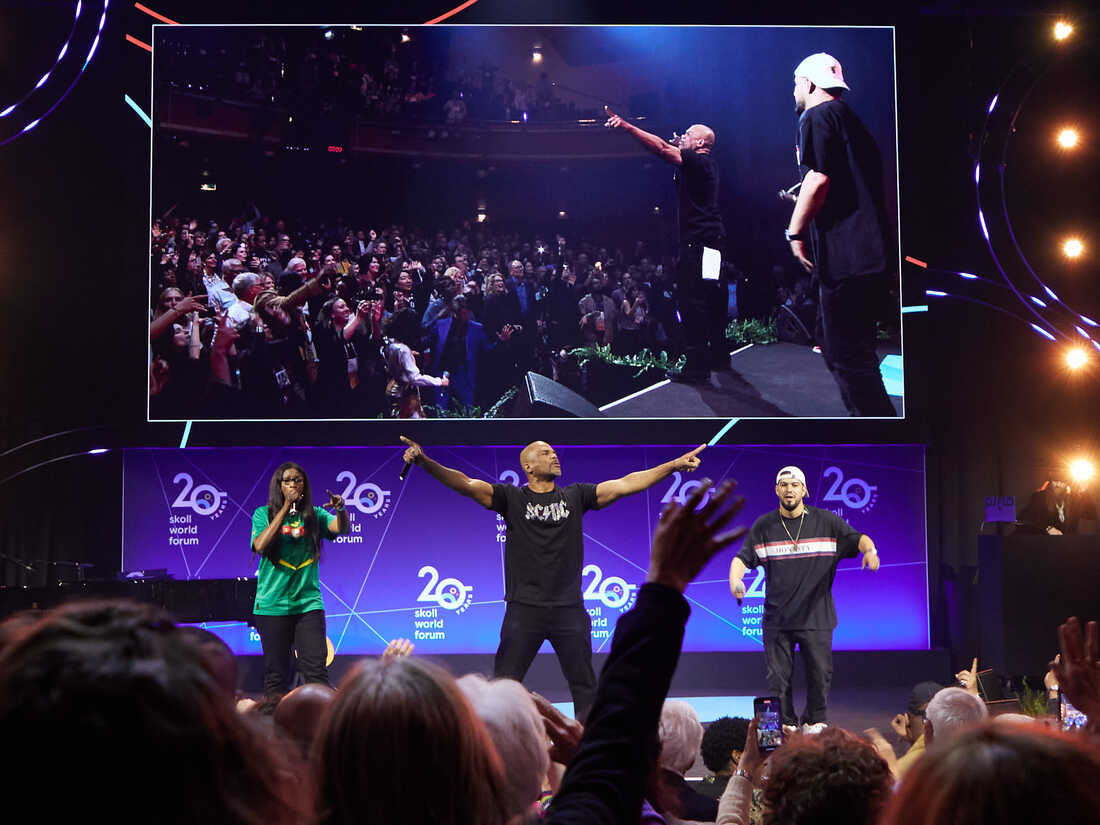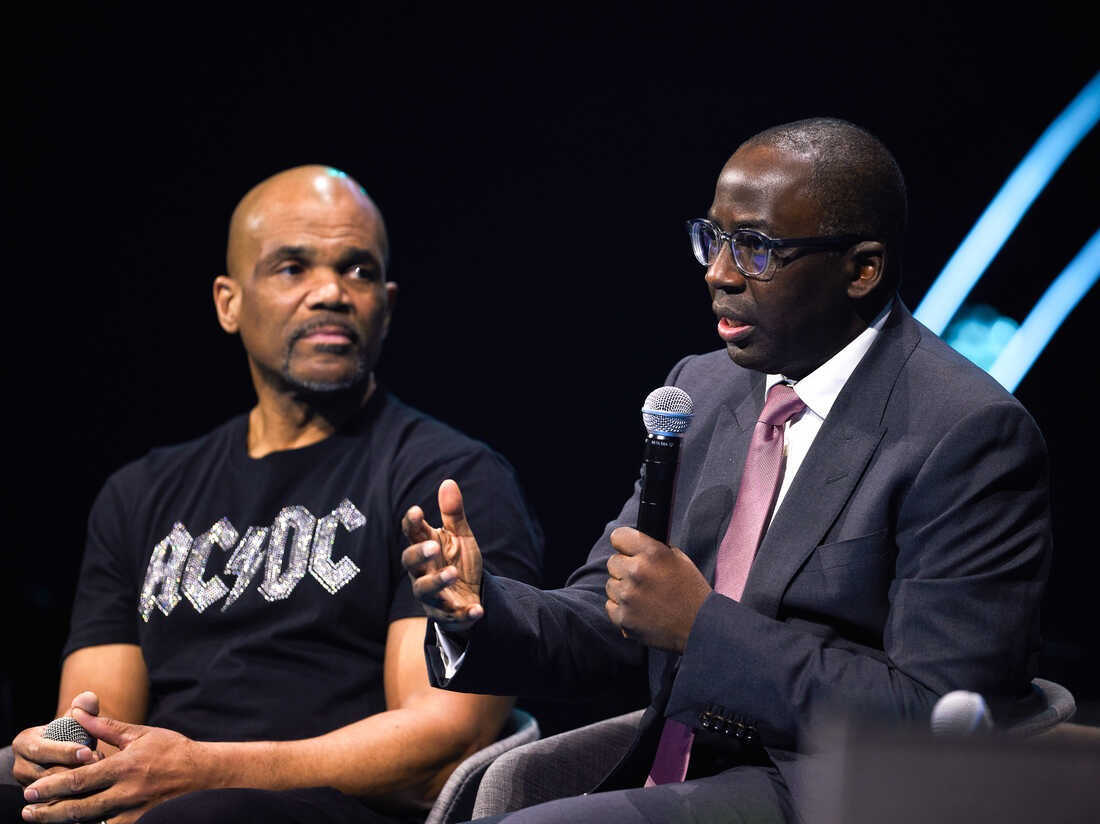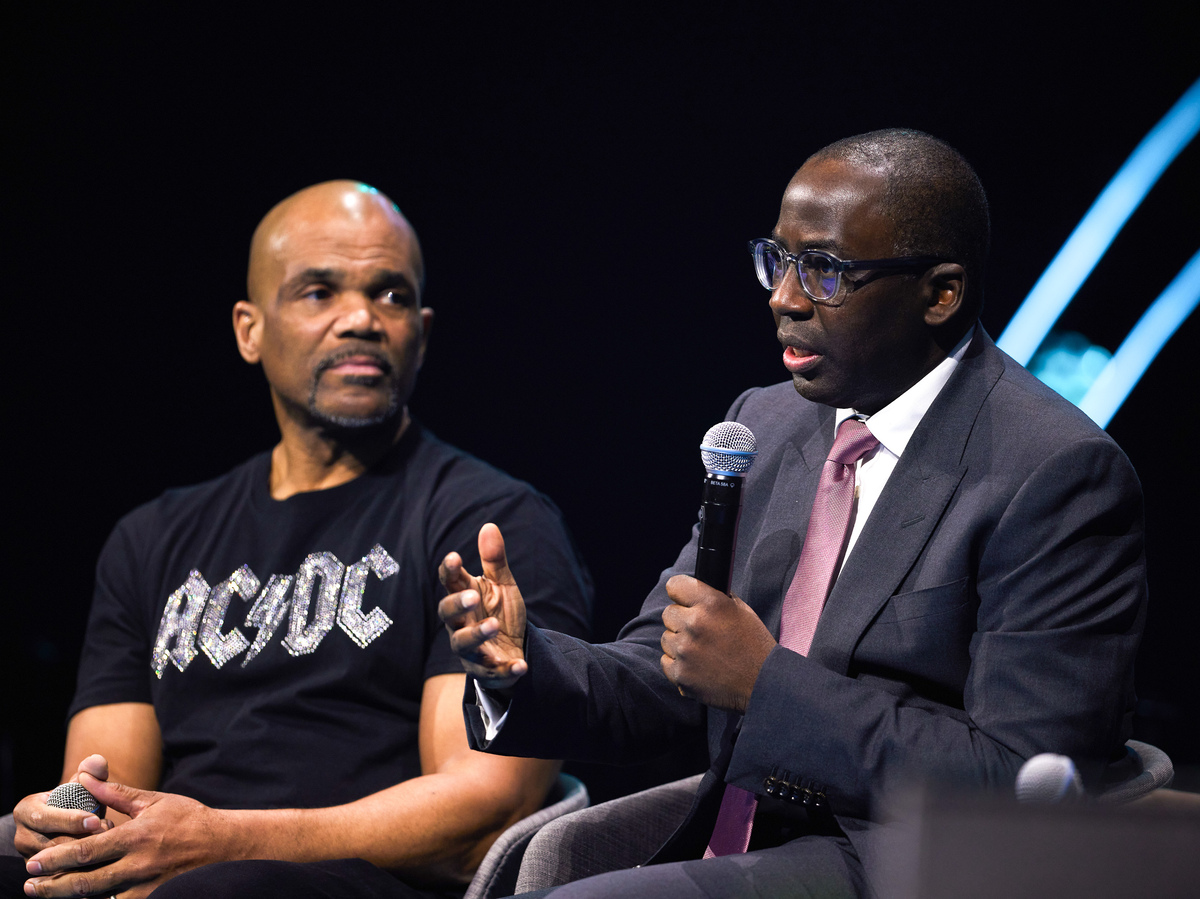
They’re hip-hop artists who weave public-health messages into their rhymes: From left: Sister Fa, Darryl “DMC” McDaniels and Ali A.Okay.A. Thoughts carry out on the Skoll World Discussion board 2023. Throughout this rap, McDaniels referred to as out: “I am not afraid of the darkish anymore/as a result of I’m the sunshine./I will be there at first of the battle/As a result of I’m the battle.”
Skoll Basis
disguise caption
toggle caption
Skoll Basis

They’re hip-hop artists who weave public-health messages into their rhymes: From left: Sister Fa, Darryl “DMC” McDaniels and Ali A.Okay.A. Thoughts carry out on the Skoll World Discussion board 2023. Throughout this rap, McDaniels referred to as out: “I am not afraid of the darkish anymore/as a result of I’m the sunshine./I will be there at first of the battle/As a result of I’m the battle.”
Skoll Basis
In 2005, Dr. Olajide Williams felt like he had two jobs. Every night, he’d end up his work as a doctor at Harlem Hospital Heart and stroll seven blocks to the studio of hip-hop artist and “The Authentic Human Beat Field” Doug E. Contemporary.
“I might be with Doug for hours and hours into the wee hours of the morning,” Williams remembers. “We might be going over completely different beats, completely different sounds.”
Their purpose was to create successful however with an uncommon lyrical premise — to show individuals how you can detect stroke signs and reply appropriately. Williams wished to exhibit that hip-hop could possibly be used for public well being interventions.
His colleagues have been doubtful. “There was lots of skepticism about whether or not this kind of work might result in a fruitful, productive” profession, he admits.

Dr. Olajide Williams (proper) was instrumental in creating the “Stroke Ain’t No Joke” hip-hop track in collaboration with rapper Doug E. Contemporary. He is sitting subsequent to Darryl “DMC” McDaniels of Run-DMC throughout a panel on hip-hop and public well being on the Skoll World Discussion board.
Skoll Basis
disguise caption
toggle caption
Skoll Basis

Dr. Olajide Williams (proper) was instrumental in creating the “Stroke Ain’t No Joke” hip-hop track in collaboration with rapper Doug E. Contemporary. He is sitting subsequent to Darryl “DMC” McDaniels of Run-DMC throughout a panel on hip-hop and public well being on the Skoll World Discussion board.
Skoll Basis
However Williams knew when it got here to extra conventional public well being interventions, “they do not diffuse into society” as simply. “Our downside isn’t developing with the solutions. Our downside is usually scaling these solutions.” To Williams, music, and hip-hop specifically, might function a strong software. “Music has at all times been in a position to diffuse not simply by means of our private lives however the world over,” he says. “And but in my thoughts, we hadn’t totally leveraged it for public well being.”
That is what Williams and Contemporary have been attempting to do in that Harlem studio. It took them weeks to get the beat and the lyrics of “Stroke Ain’t No Joke” proper, however as soon as that they had it locked in, “Doug went into the studio and I feel he knocked it out in a couple of days,” says Williams. “He was that impressed.”
YouTube
Williams says it was clear immediately that it was going to be a winner. “Once I heard these stroke signs within the hook of that observe, I knew that there was no means this wasn’t going to be simply sticky, however it was additionally going to be contagious. And we weren’t incorrect. It was extremely efficient.”
He and his colleague printed a scientific paper in Stroke, a publication of the American Coronary heart Affiliation, demonstrating that efficacy. They reported that of the 582 fourth, fifth and sixth graders in Harlem that they labored with, most discovered the place a stroke happens within the physique, what the traditional signs of stroke are and how you can take pressing motion. Williams says this information interprets into saving lives in a high-risk neighborhood like Harlem.

The world wasn’t precisely positive hip-hop could possibly be a car for public well being in addition to social justice messages. However that is precisely what has occurred, say contributors in a panel dialogue: Dr. Olajide Williams (who labored on the venture “Stroke Ain’t No Joke”) and rappers with a social conscience Darryl “DMC” McDaniels, Sister Fa and Ali A.Okay.A. Thoughts.
Skoll Basis
disguise caption
toggle caption
Skoll Basis

The world wasn’t precisely positive hip-hop could possibly be a car for public well being in addition to social justice messages. However that is precisely what has occurred, say contributors in a panel dialogue: Dr. Olajide Williams (who labored on the venture “Stroke Ain’t No Joke”) and rappers with a social conscience Darryl “DMC” McDaniels, Sister Fa and Ali A.Okay.A. Thoughts.
Skoll Basis
“Think about that fourth, fifth and sixth grade kids, by means of a hip-hop intervention, have been in a position to do what most individuals cannot do within the setting of that drama and that trauma,” mentioned Williams on the Skoll World Discussion board held in Oxford, England, final month at a session dedicated to the fiftieth anniversary of the musical style. “And that is the ability of hip-hop.”
A yr later, the group Hip Hop Public Well being was born, co-founded by Williams and Contemporary.
On this anniversary yr, Skoll wished to name consideration to this lesser identified a part of hip-hop historical past — which continues to thrive in 2023 with new rhymes and expanded programming for younger individuals.
Music has the ability … in drugs
Williams, now a neurologist at Columbia College, says that music has a job to play in drugs usually.
“Music helps us to study, music augments our recollections, music lowers our stress,” he explains. “We use it for agitated sufferers with delirium — we use music to calm them down as an alternative of utilizing restraints. For sufferers with a stroke, we use melodic intonation remedy to assist them to talk,” which refers to hitching spoken phrases and phrases to completely different pitches and rhythmic patterns to revive speech.
“Music has highly effective neurological results on our brains,” says Williams.
The staff at Hip Hop Public Well being says that hip-hop affords one thing additional in relation to the data they’re attempting to relay. Darryl “DMC” McDaniels, a hip-hop pioneer previously within the seminal group Run-DMC, says “it speaks in a youthful, enjoyable, comprehensible means” whereas packing the depth of punk rock or rock and roll.
There’s one thing common about hip-hop, says DMC, who serves on the advisory council of Hip Hop Public Well being: “Previous, younger, white, Black, even should you do not perceive English, you possibly can relate to the sensation of it. Every thing about hip-hop uniquely has a solution to encourage individuals into transformation.”
He admits this is not a brand new revelation. On the Skoll World Discussion board, DMC, egged on by Williams sitting beside him, wager that everybody within the viewers had discovered one thing basic by means of “one of many biggest hip-hop songs within the historical past” — the singsong ABC track. He took his mic, sprung to his toes, and launched into the alphabet track, concluding with, “Now your ABC’s!” Reacting to the applause, he shouted, “You recognize what I am saying!?”
Utilizing his nickname for Williams, DMC added, “So Doc is simply taking what was already being carried out and making use of it to the place it was wanted.”
And whereas Hip Hop Public Well being focuses on the U.S., worldwide hip-hop artists have infused public well being messaging into their music as nicely. As an illustration, in 2014, three Liberian musicians — D12, Shadow and Kuzzy of two Kings — created an inadvertent hit of a track referred to as “Ebola’s in City.” As NPR reported on the time, “Inside three days it was all around the nation and had impressed an unique dance the place dancers mimic kissing and hugging from a distance — a solution to preserve protected from an infection in a rustic the place individuals like to embrace once they meet.”
YouTube
On the Skoll World Discussion board, rapper Sister Fa pointed to the human rights problems with feminine genital mutilation and youngster marriage in her nation of Senegal. She mentioned most individuals did not like discussing these topics — publicly. So she turned to hip-hop “to construct a greater world.” She mentioned, “I made a decision to make use of my voice, to make use of my music to speak and to attempt to break the taboos round this follow.”
Ali A.Okay.A. Thoughts, a Colombian rapper on the identical panel, added by means of translation, “We’re attempting to make use of hip-hop as a car for transformation — not simply of the person but additionally communities themselves.”
YouTube
Nonetheless, this fusion of hip-hop and public well being wasn’t at all times straightforward for Williams to promote, particularly on the outset. When he was beginning Hip Hop Public Well being, he says, he heard considerations in regards to the “destructive drive” expressed in some hip hop — “misogyny and homophobia and materialism and poisonous masculinity.”
However Williams acknowledged that hip-hop was invented to be a drive for good. “Hip-hop was created to uplift individuals, as a cathartic car for folk to launch their ache and their pressure and their struggling. It was used to inform the story of the streets: ‘Have a look at what’s taking place right here. Have a look at what we’re enduring. We want the world to face up for justice and equality and fairness for our neighborhood.’ That was what catalyzed the rise of hip hop.”
It was these constructive components “of social activism, of social justice, of lifting individuals up” that Williams sought to leverage, notably inside communities of coloration and underserved populations. And artists like DMC have been desperate to be part of what Williams was constructing. “If hip-hop might inform individuals how you can costume, what to drive, what to smoke, what to drink and how you can act,” says DMC, “why could not hip hop inform individuals how you can reside?”
Stoked by ‘Stroke Ain’t No Joke’
“Stroke Ain’t No Joke” was the primary in what would turn out to be a sequence of hip-hop tracks utilizing the musical style “to construct well being literacy and in the end assist habits change,” says Lori Rose Benson, the CEO and government director of Hip Hop Public Well being.
The group has created greater than 200 sources to this point starting from music movies to lesson plans to educator toolkits on subjects together with diet, psychological well being, bodily exercise, dementia, oral well being, vaccine literacy, and illness prevention.
“We’re at present within the technique of concluding a randomized managed trial have a look at dementia consciousness in communities of coloration, particularly attempting to destigmatize dementia,” says Williams. “And we have created an acronym that helps acknowledge these signs of dementia.”
Benson says her staff then works with faculty districts and community-based organizations to get these supplies into the heads and arms of Okay-12 college students throughout the nation.
“So it is actually complete,” says Benson, “in order that educators will help combine this into well being schooling in faculties and after-school applications, museums, libraries — wherever that younger persons are served.”
When essential, Hip Hop Public Well being works to replace its content material. As an illustration, since “Stroke Ain’t No Joke” debuted, the suggestions round stroke detection and prevention have expanded. Initially, the acronym was FAST, which stood for a drooping of 1 facet of the face, a numbness or weak spot in an arm, slurred speech or issue talking, and in the end, should you discover these signs, it is time to name 911.
However two new letters have since been added to the beginning of the acronym to type BE FAST. Public well being professionals now suggest searching for balance issues and bother with the esure like blurred or double imaginative and prescient. That required Hip Hop Public Well being to create a wholly new observe and accompanying animated video, which was posted on Might 8 in honor of Nationwide Stroke Consciousness Month.
YouTube
Residing in a vegetable-free zone
Dr. Naa-Solo Tettey, the director of an schooling and empowerment program for cardiac well being referred to as HeartSmarts at New York Presbyterian Hospital, applauds the work of Hip Hop Public Well being. She says that it “empowers younger individuals to be targeted on their well being and wellness” at an age when their friends usually produce other considerations.
Tettey additionally acknowledges one potential disadvantage. After motivating a youngster to make adjustments to enhance their well being, she says they may suppose, “‘OK, I simply discovered in hip-hop ed that I ought to eat extra fruit and veggies, however I am unable to discover that the place I reside.’ Or, ‘I have been informed I have to train extra, however maybe I am not snug strolling exterior the place I reside.'”
In different phrases, Tettey factors to societal points that will make altering one’s habits harder than a track suggests. As an illustration, she says that folks, who may be “attempting to place dinner on the desk,” could discover it difficult to serve extra fruit and veggies and fewer fried meals.
However Tettey says these difficulties pale compared to the great that this system is doing. She says, “it is a consciousness raiser, which suggests it makes you begin fascinated by one thing. And to start out fascinated by this stuff at a younger age is simply wonderful.”
For hip-hop artist DMC, these hip-hop songs rework what would possibly in any other case be ignored or disregarded into one thing that issues. “We make the great and essential issues cool,” he says. “As an illustration, we will make going to get a colon checkup cool.”
“The one cause this actually works is this isn’t the Biden administration attempting to make rap songs,” says DMC. “The rationale why it is working — you bought Chuck D, DMC and Dougie Contemporary. ‘Nough mentioned.”
“We take the info, after which as an alternative of creating it sound prefer it’s popping out of a medical e-book,” he says, “we translate it.”
DMC says hip-hop has been in that essential enterprise of translation for years.
For instance, on the Skoll World Discussion board, when he was requested in regards to the style’s relationship with psychological well being, he referred to the 1982 track “The Message” by Grandmaster Flash and the Livid 5. He referred to as out the lyrics, “Do not push me trigger I am near the sting / I am attempting to not lose my head.”
YouTube
(In actual fact, a yr after “The Message” was launched, it spurred a PSA that inspired individuals to cross the road safely with this chorus: “Do not step out while you’re near the sting / Cease, look, pay attention, suppose, and you will not lose your head.”)
YouTube
Williams took the unique lyrics of “The Message” one step additional. “We will put security nets in our communities and hope individuals do not fall by means of the cracks,” he mentioned to the viewers on the Skoll World Discussion board. “We will put ambulances on the backside of the cliff and whisk them off to the hospital. We will put fences on the fringe of the cliff and hope individuals do not fall down. However what we actually have to do is transfer these of us additional away from the cliff so they don’t seem to be liable to falling.”